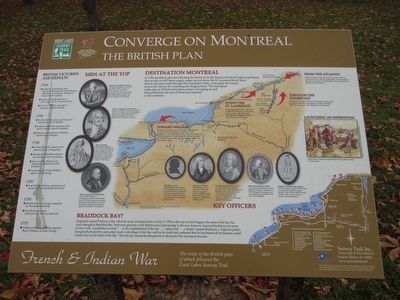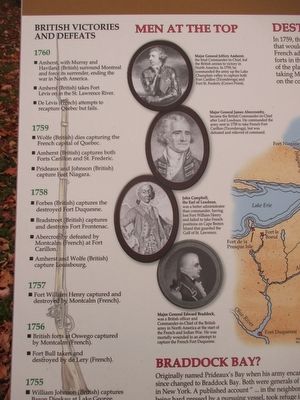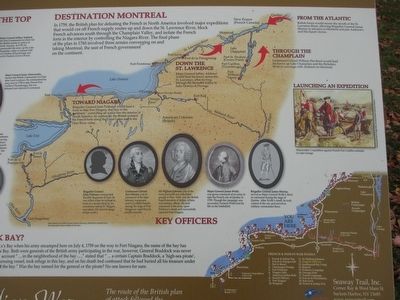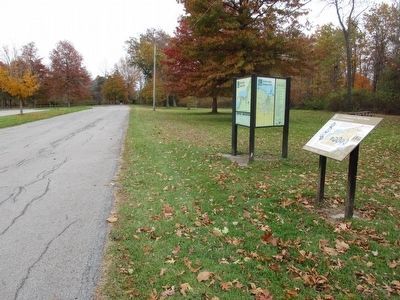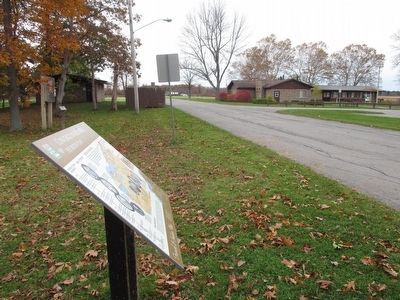Greece in Monroe County, New York — The American Northeast (Mid-Atlantic)
Converge on Montreal
The British Plan
— French & Indian War —
Destination Montreal
In 1759, the British plan for defeating the French in North America involved major expeditions that would cut off French supply routes up and down the St. Lawrence River, block French advances south through the Champlain Valley, and isolate the French forts in the interior by controlling the Niagara River. The final phase of the plan in 1760 involved three armies converging on and taking Montreal, the seat of the French government on the continent.
Toward Niagara Brigadier General John Prideaux would lead a force to take Fort Niagara, the "key to the continent," controlling all access into the interior of North America. Its capture by the British isolated the French forts along the Great Lakes and in the Ohio River valley.
Through the Champlain Lieutenant Colonel William Haviland would lead his forces up Lake Champlain and the Richelieu River to converge with Amherst on Montreal.
From the Atlantic British forces would secure the mouth of the St. Lawrence River, allowing Brigadier General James Murry to advance to Montreal and join Amherst's and Haviland's forces.
Launching an Expedition Abercromby's expedition against French Fort Carillon embarks on Lake George. Painting by Frederick Coffay Yohn, courtesy Chapman Historical Museum.
Men at the Top
Major General Jeffery Amherst, the final Commander-in-Chief, led the British armies to victory in North America. In 1759, he commanded the army up the Lake Champlain valley to capture both Fort Carillon (Ticonderoga) and Fort St. Frederic (Crown Point).
Major General James Abercromby, became the British Commander-in-Chief after Lord Loudoun. He commanded the army sent in 1758 to take French Fort Carillon (Ticonderoga), but was defeated and relieved of command.
John Campbell, the Earl of Loundoun, was a better administrator than commander, having lost Fort William Henry and failed to take French positions on Cape Brenton Island that guarded the Gulf of St. Lawrence.
Major General Edward Braddock, was a British officer and Commander-in-Chief of the British army on North America at the start of the French and Indian War. He was mortally wounded in an attempt to capture the French Fort Duquesne.
Key Officers
Brigadier General John Prideaux commanded the 55th Regiment of Foot, he was killed when he walked in front of a mortar fired by his own forces before Ft. Niagara was taken. (No known image of him exists.)
Lieutenant Colonel Eyre Massey was in command of the light infantry companies sent to La Belle Famille during the siege of Fort Niagara to repel French reinforcements.
Sir William Johnson, one of the most powerful and influential people in New York, was the British Superintendent of Indian Affairs and military officer. He took command of the army upon Prideaux's death and successfully captured Fort Niagara.
Major General James Wolfe, was given command of an army to take the French city of Quebec in 1759. Though the campaign was successful, General Wolfe lost his life on the battlefield.
Brigadier General James Murry, served as Major General Wolfe's third in command during the seige of Quebec. After Wolfe's death, he took control of the city and served as military commander there.
Braddock Bay?
Originally named Prideaux's Bay when his army encamped here on July 4, 1759 on the way to Fort Niagara, the name of the bay has since changed to Braddock Bay. Both were generals of the British army participating in the war, however, General Braddock was never in New York. A published account "... in the neighborhood of the bay...," stated that "...a certain Captain Braddock, a 'high-sea pirate', being hard pressed by a pursuing vessel, took refuge in this bay, and on his death bed confessed that he had buried all his treasure under a beech tree on the shore of the bay." Was the bay named for the general or the pirate? No one knows for sure.
British Victories and Defeats
1760
• Amherst, with Murray and Haviland (British) surround Montreal and force its surrender, ending the war in North America.
• Amherst (British) takes Fort Levis on in the St. Lawrence River.
• De Levis (French) attempts to recapture Quebec but fails.
1759
• Wolfe (British) dies capturing the French capital of Quebec.
•Amherst (British) captures both Forts Carillon and St. Frederic.
• Prideaux and Johnson (British) capture Fort Niagara.
1758
• Forbes (British) captures the destroyed Fort Duquesne.
• Bradstreet (British) captures and destroys Fort Frontenac.
• Abercromby defeated by Montcalm (French) at Fort Carillon.
• Amherst and Wolfe (British) capture Louisbourg.
1757
• Fort William Henry captured and destroyed by Montcalm (French).
1756
• British forts at Oswego captured by Montcalm (French).
• Fort Bull taken and destroyed by de Lery (French).
1755
• William Johnson (British) captures Baron Dieskau at Lake George.
The route of the British plan of attack followed the Great Lakes Seaway Trail.
Erected by Seaway Trail, Inc.
Topics and series. This historical marker is listed in this topic list: War, French and Indian. In addition, it is included in the Great Lakes Seaway Trail National Scenic Byway series list. A significant historical date for this entry is July 4, 1759.
Location. 43° 18.214′ N, 77° 42.816′ W. Marker is in Greece, New York, in Monroe County. Marker is on Braddock Bay State Parkway, ¼ mile north of East Manitou Road (County Route 140), on the right when traveling east. Marker is in Braddock Bay Park by the parking lot. Touch for map. Marker is at or near this postal address: 199 East Manitou Road, Rochester NY 14612, United States of America. Touch for directions.
Other nearby markers. At least 8 other markers are within 5 miles of this marker, measured as the crow flies. Braddock Bay Hawk Watch (about 400 feet away, measured in a direct line); Bird Migration Research (approx. 1.3 miles away); Long Pond Site (approx. 1.9 miles away); Old Trolley Route (approx. 2.2 miles away); Liberty Tree Memorial (approx. 3.2 miles away); Historic Parma Farmlands (approx. 3.8 miles away); Hojack Railroad (approx. 4 miles away); Rev War Veteran (approx. 4.3 miles away). Touch for a list and map of all markers in Greece.
Credits. This page was last revised on June 16, 2016. It was originally submitted on November 2, 2015, by Anton Schwarzmueller of Wilson, New York. This page has been viewed 486 times since then and 27 times this year. Photos: 1, 2, 3, 4, 5. submitted on November 2, 2015, by Anton Schwarzmueller of Wilson, New York.
